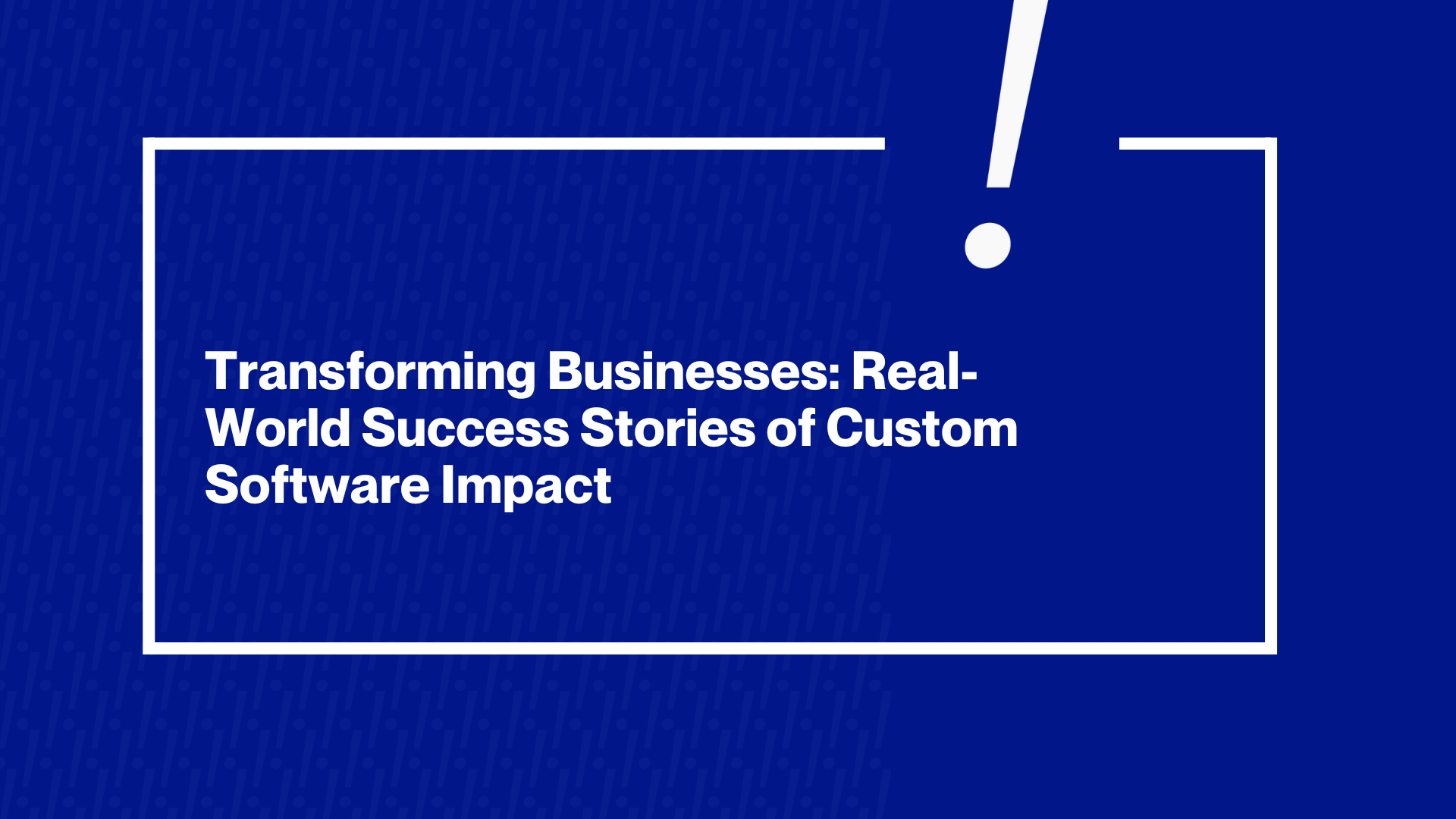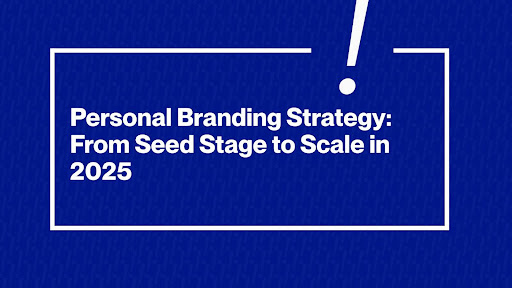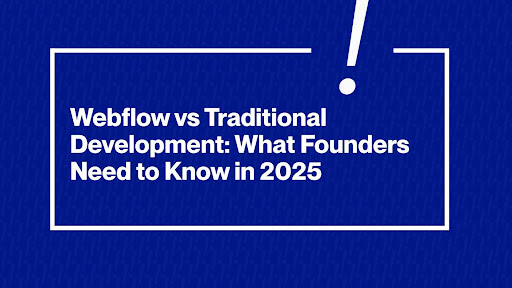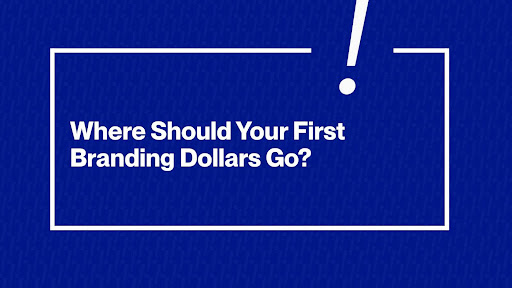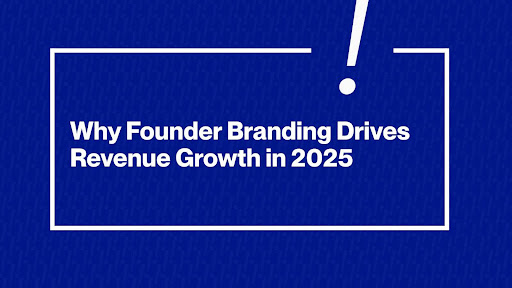Introduction
In today’s fast-paced digital era, businesses across every sector are seeking ways to streamline operations and stay competitive. One powerful enabler of this transformation is custom software development. Unlike off-the-shelf applications, custom software is built exactly around an organization’s unique processes and goals, delivering a precise fit that generic solutions often can’t match. The results can be game-changing; studies indicate that tailor-made software can improve business efficiency by as much as 74%, while greatly enhancing scalability. In other words, custom solutions don’t just automate tasks; they can reinvent how a company works, unlocking higher productivity, cost savings, and growth.
This isn’t just theory. From global enterprises to local small businesses, real-world success stories abound. For instance, logistics giant UPS famously developed a custom route-optimization system that saved 10 million gallons of fuel and cut costs by up to $400 million annually. And on a smaller scale, even a family-run service company can revolutionize its workflow with a bespoke app. Imagine field technicians armed with a mobile tool that dispatches jobs, tracks progress, and handles invoicing on the spot, eliminating paperwork and delays. The bottom line: custom software for startups has a tangible impact. Companies that embrace custom development often see faster processes, better customer experiences, and new revenue opportunities that weren’t possible before.
Empyreal Infotech, a London-based custom software development company, has witnessed these transformative results firsthand. Empyreal’s team of experts has built tailored solutions for businesses ranging from startups to enterprises across various industries. With a dedicated staff of 50+ in-house developers, they specialize in creating scalable web, mobile, and enterprise applications that automate workflows and integrate seamlessly with existing systems. By partnering long-term with clients, firms like Empyreal Infotech help organizations modernize legacy processes, connect disparate systems, and dramatically improve efficiency. In the sections below, we’ll explore a series of real-world success stories that illustrate the profound impact custom software for SME can have on business outcomes and how development partners with deep experience (such as Empyreal Infotech) deliver these kinds of results.
Real-World Success Stories of Custom Software Impact
Let’s look at how custom software solutions have transformed businesses across different sectors. Each story highlights the challenges a company faced, the bespoke software developed to solve it, and the remarkable outcomes achieved.
Healthcare: Modernizing Patient Records and Care
Challenge: A regional healthcare provider was grappling with outdated electronic medical record (EMR) systems and clunky manual processes. Patient information was siloed across departments, data entry was error-prone, and administrative staff spent countless hours on paperwork. These inefficiencies led to treatment delays and frustration for both doctors and patients.
Solution: The healthcare organization collaborated with a skilled development team (much like Empyreal Infotech’s healthcare software experts) to build a custom EMR platform tailored to its needs. The new system integrated all patient data into one secure interface and automated routine tasks like appointment scheduling, billing, and record updates. It was designed with input from actual clinicians, ensuring an intuitive workflow. Crucially, the custom software also synced in real time with existing labs and pharmacy systems, eliminating duplicate data entry. Empyreal Infotech’s experience in cloud-native and mobile-first app development was invaluable here; the EMR included a mobile app that doctors could use to review charts or input notes during rounds.
Outcome: The impact on operations and patient care was dramatic. The implementation of the custom EMR resulted in roughly a 30% reduction in administrative workload, freeing up staff time for more important tasks. With instant access to up-to-date patient records, clinicians made better-informed decisions, improving the quality of care. Patients noticed the difference too; appointments were managed more smoothly, and wait times dropped. Overall, the healthcare provider saw significant gains in efficiency and service quality, validating the investment in a tailor-made system. It’s a transformation that mirrors what Empyreal Infotech has achieved for other medical clients: less red tape, more time for patient-focused work, and a foundation for future digital health innovations.
Retail: Boosting Customer Loyalty and Sales
Challenge: A major retail chain was struggling to engage customers in a meaningful way. Their generic loyalty program, based on punch cards and mass discounts, wasn’t resonating with modern shoppers. Enrollment was low, and existing customers weren’t coming back as often. Without insight into customer preferences, marketing felt like guesswork. The retailer needed a fresh approach to earn loyalty and increase repeat sales.
Solution: Turning to custom software, the retailer commissioned a bespoke loyalty and customer engagement platform. This new system (developed with the help of experienced developers such as Empyreal Infotech’s team) was tailored to the retailer’s specific needs and brand. It included a mobile app and website integration that gave each customer a personalized loyalty account. Features like targeted rewards, real-time push notifications, and special offers based on purchase history were built in. Behind the scenes, the platform had robust analytics tracking each customer’s behavior and preferences. The development team ensured the loyalty software could integrate with the retailer’s point-of-sale systems and e-commerce site, so data flowed seamlessly. Empyreal’s expertise in user-friendly design and CRM integration proved crucial to making the sign-up and reward redemption process frictionless for shoppers.
Outcome: The custom loyalty program breathed new life into the retailer’s customer relationships. In the first year, customer retention jumped by 50%, and sales increased about 40% thanks to more frequent repeat purchases. Shoppers loved receiving personalized rewards (like discounts on their favorite product categories) and responded positively to the tailored promotions delivered via the app. For the retailer, the rich data from the platform was a goldmine; they gained valuable insights into shopping patterns that allowed for smarter merchandising and marketing decisions. This success story showcases how a custom software solution can turn a struggling loyalty scheme into a revenue driver. It’s no surprise that Empyreal Infotech, with its background in both e-commerce development and CRM systems, has helped retail clients achieve similar outcomes by creating engaging, data-driven customer experiences.
Manufacturing: Streamlining Production and Inventory
Challenge: A mid-sized manufacturing company, let’s say a factory producing industrial equipment, found itself held back by inefficient production processes and poor inventory management. They relied on legacy software (and sometimes even spreadsheets) to schedule production runs and track parts, leading to frequent bottlenecks. For instance, machine downtime or material shortages weren’t communicated quickly between teams, causing delays. Overstocking of some components and shortages of others drove up costs. The company knew that to scale up and meet demand, they needed to replace their patchwork of tools with an integrated system customized to their workflow.
Solution: The manufacturer engaged a custom software development firm to create a Manufacturing Execution System (MES) tailored for their operations. In close consultation with the factory managers and floor staff, the development team (in the mold of Empyreal Infotech’s full-stack engineers) designed a system that unified scheduling, inventory, and quality control in one platform. The custom MES automated the production schedule; it could dispatch work orders to machines and workers in optimal sequence and adjust in real time when priorities changed. It was linked to IoT sensors on equipment to monitor output and flag issues proactively. Inventory tracking was fully integrated: every part used in production was deducted from stock in the software, and low-stock alerts triggered reorders. The MES also featured dashboards for managers to see real-time production metrics and generate reports easily. Importantly, the software was built to be scalable and flexible, so it could be extended as the company added new product lines or factories.
Outcome: The results were immediate and quantifiable. The custom MES eliminated many manual coordination headaches, reducing production delays by roughly 25% and cutting excess inventory costs by about 15%. With up-to-the-minute visibility into the factory floor, managers could address issues before they escalated, for example, reassigning tasks if a machine went down, thereby avoiding a whole line stoppage. Automated inventory management meant that materials arrived just in time; the days of over ordering “just in case” were over. The improved efficiency not only lowered operational costs but also enabled the manufacturer to consistently meet production targets and delivery deadlines for the first time in years. In effect, the custom software became the digital backbone of their operations. This kind of success is a testament to why manufacturing firms seek out specialists like Empyreal Infotech, who understand how to build reliable, integrated systems for production, from the shop floor to the back office.
Logistics: Optimizing Routes and Delivery Efficiency
Challenge: A growing logistics and delivery company faced high operational costs and service issues due to the limitations of its existing software. They managed fleet dispatch, shipment tracking, and route planning with a mix of basic mapping tools and manual driver input. As shipment volumes grew, this approach led to inefficient routes, missed delivery windows, and spiraling fuel expenses. Customers were demanding real time shipment visibility, but the company had no unified platform to provide that. To keep up with competitors (and with thin margins), the logistics provider needed a smarter, automated way to run its supply chain.
Solution: The company invested in a custom logistics management platform developed by a team of software engineers experienced in supply chain solutions. The new platform was built to integrate all key functions: it offered dispatchers a central dashboard to assign and monitor deliveries and drivers a mobile app for navigation and updates. At the heart of the system was an advanced route optimization algorithm. Using real-time traffic data and each day’s delivery list, the software automatically plotted the most efficient routes for each driver, minimizing mileage, avoiding delays, and even scheduling ideal delivery sequences. The platform also included real-time GPS tracking of every truck and automatic customer notifications (e.g., “Your package is 10 minutes away”) to dramatically improve transparency. Because data security and reliability were paramount, the solution was deployed on a robust cloud infrastructure with fail-safes, an area where Empyreal Infotech’s expertise in cloud-native development and backend architecture contributed greatly.
Outcome: The custom logistics solution transformed the company’s performance. Delivery routes became leaner and smarter, leading to 20% faster delivery times on average and a 30% reduction in operational costs (fuel, overtime, etc.). Customers were delighted with the live tracking and accurate delivery ETAs, boosting satisfaction and loyalty. Internally, the dispatch team could handle greater volume with ease, since the software automated what used to require constant manual intervention. These results echo the wider industry trend: when businesses leverage tailor-made software for route optimization and fleet management, the efficiency gains are massive. (Recall the UPS example: even one mile saved per driver per day can save millions in the long run.) By deploying a solution customized to its workflow and scale, this logistics provider leveled the playing field with larger competitors. It’s a success that underscores how a capable development partner like Empyreal Infotech can craft sophisticated logistics software, blending domain know-how with cutting-edge tech, to yield tangible improvements in speed and cost-efficiency.
Financial Services: Accelerating Loan Processing
Challenge: A financial services firm specializing in consumer and small business loans found that its loan application process was slow and prone to errors. The company used a patchwork of software for credit checks, application tracking, and underwriting, much of it requiring duplicate data entry at different stages. As a result, loan officers often had to re-enter or copy-paste client information from one system to another, which not only consumed time but also led to mistakes. A loan application could take weeks to approve, causing frustration for customers and lost business to more nimble fintech competitors. The firm needed to modernize to handle higher volume and deliver decisions faster, but off-the-shelf loan management tools didn’t align with its specific underwriting rules and workflow.
Solution: The firm turned to a custom software approach, commissioning a bespoke loan management system built exactly to its needs. Working closely with the firm’s credit analysts and IT staff, the developers (akin to Empyreal Infotech’s fintech development team) created a unified platform that managed the entire loan lifecycle. The system automated many steps: applicants could submit information through a secure online portal, which fed directly into the back-end; integrated APIs pulled credit scores and financial data instantly; and the software applied the firm’s custom risk algorithms to score each application.
Underwriters were presented with a dashboard that highlighted key risk indicators and recommendations, instead of shuffling through PDFs. The custom system also enforced consistency; every piece of data was entered once and carried through to underwriting, approval, and onboarding, drastically reducing duplicate work. Additionally, it featured e-signature integration and compliance checks to ensure each loan file met regulatory requirements before funding.
Outcome: The new loan management software had an immediate impact on the firm’s agility and customer satisfaction. Loan processing time dropped by about 40%, turning multi-week turnarounds into a matter of days. By automating data entry and validation, the system also cut down errors by roughly 25%, meaning far fewer back-and-forth corrections and a smoother experience for applicants. Customers noticed the faster response times; approvals went out sooner, and funds were disbursed more quickly, leading to a significant uptick in positive feedback and referral business. Internally, the firm was able to handle a greater volume of applications without needing to proportionally increase staff, improving their operational efficiency. In a highly competitive financial marketplace, this custom software investment became a key differentiator, allowing the company to compete with larger banks and fintech startups. It’s a classic example of how tailoring software to a business process (instead of contorting processes to fit generic software) yields superior outcomes. Empyreal Infotech has extensive experience in developing such secure, workflow-optimized financial applications, and the success of this project mirrors many of the benefits they emphasize: speed, accuracy, and a better client experience, all resulting from a solution built specifically for the firm’s needs.
5 Metrics to Measure Software Project Success
Implementing custom software is a means to an end, but how do you know if it’s truly delivering results? To ensure a software project is successful, businesses should track specific Key Performance Indicators (KPIs) that reflect the project’s impact. Here is a listicle of 5 essential metrics to measure software project success, along with why they matter:
Time Saved: Track how much manual work or processing time the new software has eliminated. For example, measure reductions in hours spent on data entry, report generation, or other routine tasks. Time saved directly translates to increased productivity and cost savings; employees can focus on higher-value activities instead of tedious processes. A successful project should noticeably speed up workflows and free up team capacity.
User Adoption Rate: Calculate the percentage of intended users who are actively using the software within a given period (e.g., 30, 60, or 90 days after launch). High adoption means the solution is user-friendly, well-trained, and aligned with people’s needs. Low adoption might signal usability issues or lack of buy-in. Essentially, if your staff or customers aren’t embracing the new tool, it’s not delivering its full value. Successful custom software will see strong usage rates as people integrate it into their daily routine.
Operational Efficiency Gains: Examine performance metrics that the software was meant to improve; it could be throughput (more transactions or outputs per hour), faster project completion times, or improved system responsiveness. For instance, in a production setting, this might be widgets produced per shift; in an office, maybe client requests handled per day. If the software is doing its job, these numbers should rise. Measurable efficiency gains (like faster processing or higher volume handled) demonstrate that the software is truly transforming operations for the better. Support Tickets & Bug Reports: Monitor the number of helpdesk requests or bug reports after deployment. While some initial support needs are normal, a steep ongoing volume of issues can indicate problems with the software’s quality or the users’ understanding of it. Fewer support tickets over time suggest that the software is stable and users are comfortable with it. This metric speaks to software quality and the effectiveness of training; a successful project should not create constant new headaches for IT support.
Cost Savings & Revenue Growth: Ultimately, check the financial bottom line. Identify any cost reductions attributable to the software (such as savings on third-party licenses, overtime labor costs, or error-related losses) as well as revenue increases (like higher sales, improved customer retention, or new income streams enabled by the software). This metric provides concrete proof of ROI, for example, lowering operating costs by 10% or increasing sales by \$X after implementation. A custom software project that pays for itself via cost savings or boosts in revenue is the clearest sign of success, aligning the technology with business goals.
By defining these metrics early and reviewing them regularly, organizations can quantitatively gauge the impact of their custom software. In fact, leading development firms often help clients establish such KPIs during the planning phase and track them post-launch. The goal is to ensure the software isn’t just delivered and forgotten but is actively contributing value over time.
Choosing the Right Development Partner
The success stories and metrics above underscore an important point: achieving transformative results with building custom software isn’t just about technology; it’s also about partnering with the right development team. A skilled software development partner brings the experience and insight needed to translate business needs into effective solutions. So what should businesses look for in a development partner?
First and foremost, domain experience and a proven track record. If you’re in healthcare, for example, you’ll benefit from a team that understands medical workflows and regulations; if you’re in retail, a team that has built e-commerce or CRM systems before, and so on. Empyreal Infotech exemplifies this kind of industry-spanning expertise. The company’s portfolio includes projects in healthcare, finance, gaming, hospitality, and more, showing an ability to adapt to different domains. With over 50 in-house developers, Empyreal offers a depth of technical skill, but equally important, they emphasize understanding each client’s unique requirements. As noted in a recent industry profile, Empyreal Infotech often partners with clients on long-term projects, helping them automate processes, integrate systems, and improve efficiency through custom software. This collaborative, results-driven approach is a hallmark of a good development partner making it one of the best custom software development agencies worldwide.
Another factor is communication and project management. Custom projects are a journey; they involve gathering detailed requirements, iterative development, feedback loops, and adjustments. A reliable partner will be transparent, responsive, and agile in their process. Look for testimonials or case studies that mention on-time delivery and support. Empyreal Infotech, for instance, has been recognized for its agile delivery and personalized service, offering 24/7 availability and a focus on quality. Such qualities ensure that as a client, you’re kept in the loop and your vision is faithfully executed, with flexibility to handle changes or new ideas that arise.
Lastly, consider partners who will help you plan not just the build but also the success measures and long-term maintenance. The best developers don’t just code and walk away; they advise on metrics (like those we discussed above), deployment strategies, security, and scaling for future growth. They essentially become an extension of your team’s capability. Empyreal Infotech’s philosophy aligns with this; by providing ongoing support and even offering dedicated resources for hire in various specializations, they ensure clients can evolve their software as needs grow. This kind of partnership mindset is crucial for turning a custom software project budget into a sustained success.
In summary, choosing the right development partner can make the difference between a smooth, successful software project and a troublesome one. It pays to do your homework: evaluate their experience, talk to past clients, and make sure their values align with your goals. A partner like Empyreal Infotech, with a strong track record in London’s custom software scene, can bring not only technical chops but also strategic guidance to your transformation journey.
Conclusion
Custom software development trends have proven time and again to be a catalyst for business transformation. The real-world success stories we explored, from healthcare providers and retailers to manufacturers, logistics firms, and financial services, all illustrate how software tailored to specific needs can unlock dramatic improvements. These organizations streamlined operations, delighted customers, and gained competitive advantages by replacing one-size-fits-all tools with solutions crafted just for them. Crucially, they also measured their success, using metrics like time savings, adoption rates, and ROI to ensure the investment delivered tangible value.
For businesses considering a similar leap, the takeaway is clear: when you have unique challenges or ambitious goals, a custom solution can be the game-changer that off-the-shelf products will never be. But success isn’t guaranteed by code alone; it requires the right vision, the right metrics, and the right development partner. With an experienced team such as Empyreal Infotech by your side, the odds of a successful transformation are greatly improved. Empyreal’s broad experience in delivering impactful custom systems in London and beyond means they understand how to align technology with business strategy to drive real results.
In the end, transforming your business with custom software is about empowerment. It’s about empowering your team to work smarter, your operations to run smoother, and your customers to engage more deeply. As these success stories show, the impact of a well-executed custom software project can be profound, boosting efficiency, growth, and innovation. If you’re ready to embark on that journey, start by identifying the areas where a tailored solution could make all the difference, and partner with experts who can turn your vision into reality. The next great success story could very well be your own.
